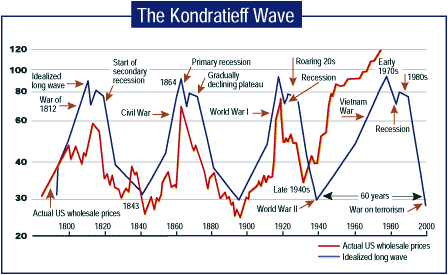The Foundation Of Wave Economics
Riding The
Kondratieff Wave
by Tim Elrod
I first found out about Kondratieff's long wave theory in college. I was sitting in a library courtyard at University of California (Berkeley), and it occurred to me that there was as much mysticism and wonder in business as there was in religion or philosophy. I also concluded that the foundation of economics was suspect, a relic of the caretaker class of journalists, academics, and government bureaucrats. Maybe supply and demand worked randomly in the short term but to really see the market, explain it, and forecast it, it occurred to me that price needed to be looked at purely as a function of time. This, I realized, is the foundation of wave economics.
THE LONG WAVE
Nicolai Kondratieff, a Russian economist, discovered the 54-year cycle
in the 1920s, and was banished to the Siberian gulag for his trouble. Harvard
economist Joseph Schumpeter was keen on business cycle theory, and during
the 1920s and 1930s further refined and embroidered on Kondratieff's work.
The long wave is basically a 54-year rhythm of wholesale prices -- a systole
and diastole of inflation and deflation, if you will -- that influences
and permeates all of politics and culture, including wartime (Figure
1). There is war at the peaks and at the troughs of the
cycle. In 1814, 1865, 1920, and 1972, wars accompanied the inflationary
long-wave highs as a climax to the social tensions and inflation of the
two decades previous.

Figure 1: THE KONDRATIEFF WAVE. Peaks and troughs are associated with major political or cultural events.
...Continued in the September 2002 issue of Technical Analysis of STOCKS & COMMODITIES
Excerpted from an article originally published in the September 2002 issue of Technical Analysis of STOCKS & COMMODITIES magazine. All rights reserved. © Copyright 2002, Technical Analysis, Inc.